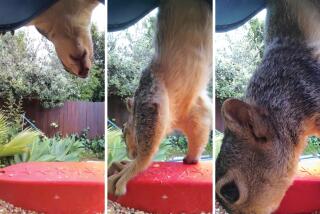Out of the Wild : Nature: Encounters between people and snakes are more frequent in warmer months. Officials are kept busy rounding the reptiles up.
The tail rattle was unmistakable, the raw sound a contrast with the delicate features of its owner.
The 18-inch rattlesnake with a perfect camouflage--skin of black diamonds on a dirt-colored background--was getting a little testy. That morning, it had been captured in a Topanga back yard, then unceremoniously dumped into a rectangular wooden box.
And as it was being released into the wild of Agoura Hills, the snake wasted no time slithering under a nearby rock and giving a last rattle to its captors.
“He’s saying, ‘I’ve had enough of all this,’ ” said the snake’s liberator, Officer Lori Weston of the Los Angeles County Animal Regulation Department.
This particular Southern Pacific rattlesnake was one of many the agency has trapped this summer in the area patrolled by its shelter staff in Agoura Hills. Rattlesnakes, like humans, spend more time in the open during hot weather. So with people in the Valley encroaching on lands left mostly to snakes during cooler months, encounters between man and snake are more frequent.
Between 1988 and 1990, animal-control officers at the Agoura Hills shelter trapped an average of 137 rattlesnakes a year in the area stretching from Woodland Hills to Westlake Village. Most were caught between May and August. Although numbers have not been monitored since then, Lt. Gail Miley said she believes even more have been caught in recent years.
“We’re definitely encroaching on areas that are wildlife habitat,” she said. “Pretty much every year the problem has increased.”
The San Fernando Valley is home to several varieties of snake--including the gopher, the racer and the king. The gopher, or bullsnake, is particularly common. It is a hunter with an appetite so insatiable that it frequently turns up in homes, and even hot tubs, of Valley residents, as it searches for frogs, rats or just about anything else that moves.
It also does impersonations.
“A lot of times, people mistake gophers for rattlesnakes,” Miley said because they can hiss loudly and thrash about while vibrating their tails.
But no local snake has the fearsome reputation--or the poisonous venom--of the rattler. The Southern Pacific rattlesnake-- Crotalus viridus helleri --is the most common species in the Los Angeles area, with adults averaging about 3 1/2 feet in length.
The Southern Pacific is generally not as large, aggressive or dangerous as desert cousins such as the diamondback and the Mojave green, according to Cynthia Webber, collections manager for herpetology at the county Museum of Natural History.
But, “any rattlesnake bite would be serious,” she said.
Man-eating crocodiles could hardly incite more fear than the appearance of a rattlesnake in a back yard, animal-control workers say.
“People get really upset, really hysterical,” Weston said. “They think the snake will chase them down and kill them.”
Miley recalled one family that was almost driven from their Westlake Village home by rattlesnakes. After brush was cleared from a hillside near the house, about a dozen snakes that were nesting in the brush migrated down the hill into the family’s garage.
“The family were seriously thinking of moving,” Miley said, until she gave them a class on how to avoid dangerous situations with snakes.
During the winter, rattlers pose little threat, as they spend the colder months hibernating in rockslides or crevices. Even on summer days, they would much rather be curled under some shade than sporting themselves out in the open sun. Only as the sun goes down, and as their rodent prey becomes more active, do they tend to emerge.
But experts warn that a rattlesnake encounter could happen just about any time during the summer. As habitats collide in the suburbs of the Valley, common human summer activities such as re-stacking the woodpile, clearing brush or even cleaning out the pool could mean a close encounter of the slithery kind.
“We’ve found them in pool-skimmers,” Miley said. “There’s a hole in most skimmers you can put your finger in. A lot of times, a snake will drop into the hole.”
According to animal-control officials, some people respond to a snake find by grabbing the nearest shovel or other heavy garden tool and battering the intruder to death. Officials recommend calling the local animal shelter instead.
The county trappers pick up the snake with specially designed tongs and deposit it in a snake box through the smaller of two latched doors in the contraption. The snake is usually a willing victim.
“By nature, rattlesnakes are fairly shy, so they go right for the dark hole,” Miley explained.
Shelter officials in more urban parts of Los Angeles County have little choice but to kill the reptiles. Out in Lt. Miley’s territory, which fringes the largely undeveloped foothills of the Santa Monica Mountains, it is easy to move the snakes to the wild.
In the case of the displaced Topanga rattler, it was deposited within a mile of the Agoura Hills shelter, where it nestled under a rock beside a seldom-used little footpath. As she freed the snake, Weston’s sympathies were with the reptile.
“The public needs to be educated toward living with wildlife rather than removing it,” she said. “People don’t want rattlesnakes around. . . . But they have a place, too.”
More to Read
Sign up for Essential California
The most important California stories and recommendations in your inbox every morning.
You may occasionally receive promotional content from the Los Angeles Times.










